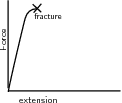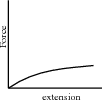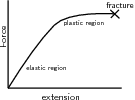| << Chapter < Page | Chapter >> Page > |
A spring has a spring constant of N.m . By how much will it stretch if a load of 50 N is applied to it?
We know that if you have a small spring and you pull it apart too much it stops 'working'. It bends out of shape and loses its springiness. When this happens, Hooke's Law no longer applies, the spring's behaviour deviates from Hooke's Law.
Depending on what type of material we are dealing with, the manner in which it deviates from Hooke's Law is different. We give classify materials by this deviation. The following graphs show the relationship between force and extension for different materials and they all deviate from Hooke's Law. Remember that a straight line show proportionality so as soon as the graph is no longer a straight line, Hooke's Law no longer applies.

This graph shows the relationship between force and extension for a brittle, but strong material. Note that there is very little extension for a large force but then the material suddenly fractures. Brittleness is the property of a material that makes it break easily without bending.
Have you ever dropped something made of glass and seen it shatter? Glass does this because it is brittle.

Here the graph shows the relationship between force and extension for a plastic material. The material extends under a small force but it does not fracture easily, and it does not return to its original length when the force is removed.

In this graph the relationship between force and extension is for a material that is ductile. The material shows plastic behaviour over a range of forces before the material finally fractures. Ductility is the ability of a material to be stretched into a new shape without breaking. Ductility is one of the characteristic properties of metals.
A good example of this is aluminium, many things are made of aluminium. Aluminium is used for making everything from cooldrink cans to aeroplane parts and even engine blocks for cars. Think about squashing and bending a cooldrink can.
Brittleness is the opposite of ductility.
When a material reaches a point where Hooke's Law is no longer valid, we say it has reached its limit of proportionality . After this point, the material will not return to its original shape after the force has been removed. We say it has reached its elastic limit .
The elastic limit is the point beyond which permanent deformation takes place.
The limit of proportionality is the point beyond which Hooke's Law is no longer obeyed.

Notification Switch
Would you like to follow the 'Siyavula textbooks: grade 12 physical science' conversation and receive update notifications?